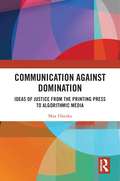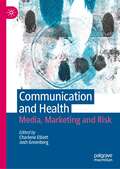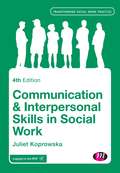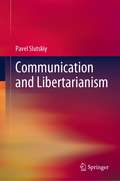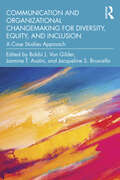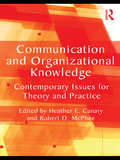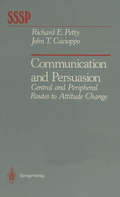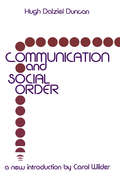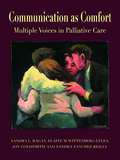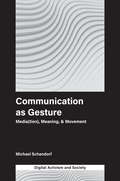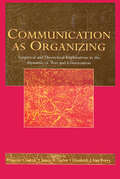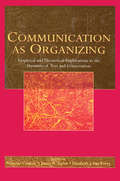- Table View
- List View
Communication Against Domination: Ideas of Justice from the Printing Press to Algorithmic Media
by Max HänskaThis book tackles the philosophical challenge of bridging the gap between empirical research into communication and information technology, and normative questions of justice and how we ought to communicate with each other. It brings the question of what justice demands of communication to the center of social science research. Max Hänska undertakes expansive philosophical analysis to locate the proper place of normativity in social science research, a looming subject in light of the sweeping roles of information technologies in our social world today. The book’s first section examines metatheoretical issues to provide a framework for normative analysis, while the second applies this framework to three technological epochs: broadcast communication, the Internet and networked communications, and the increasing integration of artificial intelligence and machine learning technologies into our communication systems. Hänska goes beyond the prevailing frameworks in the field by exploring how we answer normative questions and how our answer can change depending on our social context and the affordances of prevailing communications technologies. This book provides an essential guide for scholars as well as graduate and advanced undergraduate students of research and theory in communication, philosophy, political science, and the social sciences.
Communication and Community in the New Media Age (China Perspectives)
by Wang BinThis book investigates the relationship between information communication and community development in China in the new media age, drawing on theoretical resources from journalism, communication, urban sociology, community management, and the activities of social movements. Contrasting existing scholarship that centers on new technologies and virtual aspects of today’s communication, the study highlights community residents’ daily praxis in real social spaces and the interaction between online and offline communications. Through content analysis, case studies, questionnaire surveys, and in-depth interviews, the author explores the social engagement of communication in public expressions and negotiations among Chinese urban communities. From micro, meso and macro levels respectively, three interactive mechanisms are discussed: (1) media use and social consciousness and mobilization; (2) new media and changes in community governance; and (3) state-community interplay. Based on these mechanisms, the author proposes the idea of “the construction of grassroots social communication”, exploring approaches to the modernization of social governance and attainment of social interests by optimizing information communication. Communication and Community in the New Media Age will appeal to academics and students studying communication and social transition in China, new media and society, urban sociology, and public governance.
Communication and Community in the New Media Age (China Perspectives)
by Wang BinThis book investigates the relationship between information communication and community development in China in the new media age, drawing on theoretical resources from journalism, communication, urban sociology, community management, and the activities of social movements. Contrasting existing scholarship that centers on new technologies and virtual aspects of today’s communication, the study highlights community residents’ daily praxis in real social spaces and the interaction between online and offline communications. Through content analysis, case studies, questionnaire surveys, and in-depth interviews, the author explores the social engagement of communication in public expressions and negotiations among Chinese urban communities. From micro, meso and macro levels respectively, three interactive mechanisms are discussed: (1) media use and social consciousness and mobilization; (2) new media and changes in community governance; and (3) state-community interplay. Based on these mechanisms, the author proposes the idea of “the construction of grassroots social communication”, exploring approaches to the modernization of social governance and attainment of social interests by optimizing information communication. Communication and Community in the New Media Age will appeal to academics and students studying communication and social transition in China, new media and society, urban sociology, and public governance.
Communication and Health: Media, Marketing and Risk
by Charlene Elliott Josh GreenbergThis book explores the unique contribution that critical communication studies can bring to our understanding of health. It covers several broad themes: representing and mediating health; marketing and promoting health, co-producing health; and managing health crises and risks. Chapters speak to moral and social regulation through health communication, technologies of health, healthism and governmentality. They engage with historical and contemporary issues, offering readers theoretically grounded perspectives. At base, the book explores what a critical communication approach to health might look like, revealing in important—and sometimes surprising—ways how communication sits at the centre of understanding how health is constructed, contested, and made meaningful.
Communication and Information Technologies Annual: Doing and Being Digital: Mediated Childhoods (Studies in Media and Communications #8)
by Laura Robinson Shelia Cotten Jeremy SchulzThis volume assembles cutting edge research focusing on media and youth. The volume looks broadly at what is understood by the definitions of 'youth' and 'media', when studied together and separately, and how these continue to develop. The volume features papers about institutions that shape this part of the lifecourse, such as the family, school, community organizations. Papers address this theme from a theoretical and methodological framework.
Communication and Information Technologies Annual: Politics, Participation, And Production (Studies in Media and Communications #9)
by Laura Robinson Shelia Cotten Jeremy SchulzSponsored by the Communication and Information Technologies Section of the American Sociological Association, this volume brings together nine studies of the digital public sphere. The contributions illuminate three key areas of digital citizenship, namely political engagement, participation networks, and content production. In the first section, authors address relationships including: new media and efficacy, YouTube and young voters, political interest and online news. In the following section, the contributions speak to the importance of participation in social, scholarly, familial, and support networks. Subsequently, in section three on production, two contributions offers insight into unequal production, more specifically, gendered digital production inequalities and the varied responsiveness of microbloggers to different kinds of media events and issues. As a whole, the contributions revisit old questions and answer important new queries about netizenship and the digital public sphere.
Communication and Interpersonal Skills in Social Work (Fourth Edition) (PDF)
by Juliet KoprowskaAlthough communication and interpersonal skills are widely-taught as a core element of the social work degree, understanding the theory and processes around them can be a challenge. This book starts with the fundamentals and looks at individual theories and approaches, relating them directly to social work practice. This approach will help you to understand the benefits that good communication skills can bring to your practice placements and work with clients. The content is grounded in social work practice and is totally skills-focused. There are new sections on groupwork, working with vulnerable clients and communicating effectively with children. Key updates: A new chapter on working with groups A revised chapter on working with families More material on emotional intelligence More material on relationship based social work This book is in the Transforming Social Work Practice series. All books in the series are affordable, mapped to the Social Work Curriculum, practical with clear links between theory amp; practice and written to the Professional Capabilities Framework.
Communication and Learning Revisited: Making Meaning Through Talk (Routledge Revivals)
by Douglas Barnes Frankie ToddFirst published in 1995, Communication and Learning Revisited focuses on the importance and benefits of group dialogue in cooperative learning. The book explores the use of group dialogue among students across a variety of disciplines and demonstrates how collaboration helps them to understand different concepts. It outlines cognitive and social strategies that can enhance collaboration and presents collaborative talk’s role in learning, setting forth a theoretical framework that draws upon the ideas of writers such as Vygotsky and Bakhtin. Communication and Learning Revisited will appeal to those with an interest in teaching methods, classroom dialogue, and cooperative learning.
Communication and Learning Revisited: Making Meaning Through Talk (Routledge Revivals)
by Douglas Barnes Frankie ToddFirst published in 1995, Communication and Learning Revisited focuses on the importance and benefits of group dialogue in cooperative learning. The book explores the use of group dialogue among students across a variety of disciplines and demonstrates how collaboration helps them to understand different concepts. It outlines cognitive and social strategies that can enhance collaboration and presents collaborative talk’s role in learning, setting forth a theoretical framework that draws upon the ideas of writers such as Vygotsky and Bakhtin. Communication and Learning Revisited will appeal to those with an interest in teaching methods, classroom dialogue, and cooperative learning.
Communication and Libertarianism
by Pavel Slutskiy"This is an outstanding contribution to both libertarian political philosophy and communication theory. It is far and away the most comprehensive work on communication issues in libertarian theory ever published. The author has integrated successfully the libertarian insights of Mises, Rothbard, Block, Kinsella and others with the philosophy of language as developed by Austin, Searle and Grice. He has done so in a unique and unprecedented way. The book would appeal to students and scholars interested in libertarian theory and more generally, to philosophers and political scientists interested in high-level scholarship.” - David Gordon, libertarian philosopher and intellectual historian, Ludwig von Mises Institute.
Communication and Organizational Changemaking for Diversity, Equity, and Inclusion: A Case Studies Approach
by Van Gilder, Bobbi J. Jasmine T. Austin Jacqueline S. BruscellaThis book explores the opportunities, challenges, and effective approaches to organizational change regarding diversity, equity, inclusion, and belonging. Featuring application-based case studies and practical guidelines for meaningful organizational change, this book problematizes some of the current DEI initiatives in today’s organizations. It examines multiple forms of diversity (e.g., race, age, and mental health) from a variety of perspectives (e.g., leadership and employee), with case studies that demonstrate how changemaking efforts can be reimagined and implemented in better, more nuanced, and more sustainable ways to produce meaningful organizational change. Through these case studies, readers learn from organizations’ successes and failures in their attempts to implement DEI practices. Each chapter concludes with explicit practical implications and/or actionable recommendations for organizational changemaking. This text will make an impactful addition to courses in communication and diversity or organizational communication/change at the advanced undergraduate or graduate level, and will be an essential guide for professionals wishing to lead change in their organizations.
Communication and Organizational Changemaking for Diversity, Equity, and Inclusion: A Case Studies Approach
This book explores the opportunities, challenges, and effective approaches to organizational change regarding diversity, equity, inclusion, and belonging. Featuring application-based case studies and practical guidelines for meaningful organizational change, this book problematizes some of the current DEI initiatives in today’s organizations. It examines multiple forms of diversity (e.g., race, age, and mental health) from a variety of perspectives (e.g., leadership and employee), with case studies that demonstrate how changemaking efforts can be reimagined and implemented in better, more nuanced, and more sustainable ways to produce meaningful organizational change. Through these case studies, readers learn from organizations’ successes and failures in their attempts to implement DEI practices. Each chapter concludes with explicit practical implications and/or actionable recommendations for organizational changemaking. This text will make an impactful addition to courses in communication and diversity or organizational communication/change at the advanced undergraduate or graduate level, and will be an essential guide for professionals wishing to lead change in their organizations.
Communication and Organizational Knowledge: Contemporary Issues for Theory and Practice (Routledge Communication Series)
by Heather E. CanaryThis book provides an overview of communication-centered theory and research regarding organizational knowledge and learning. It brings the work of scholars in communication, management, information technology, and other disciplines together in a coherent volume that represents existing research and theory on communication-related knowledge work. Chapters address what constitutes knowledge, how knowledge functions within and across organizations, and how organizational members develop and manage knowledge for organizational purposes. The book also provides a forum for these scholars to pose directions for future research and theorizing. It will serve as a reference tool for scholars and practitioners to identify and understand communicative features of organizational knowledge processes.
Communication and Organizational Knowledge: Contemporary Issues for Theory and Practice (Routledge Communication Series)
by Heather E. Canary Robert D. McPheeThis book provides an overview of communication-centered theory and research regarding organizational knowledge and learning. It brings the work of scholars in communication, management, information technology, and other disciplines together in a coherent volume that represents existing research and theory on communication-related knowledge work. Chapters address what constitutes knowledge, how knowledge functions within and across organizations, and how organizational members develop and manage knowledge for organizational purposes. The book also provides a forum for these scholars to pose directions for future research and theorizing. It will serve as a reference tool for scholars and practitioners to identify and understand communicative features of organizational knowledge processes.
Communication and Persuasion: Central and Peripheral Routes to Attitude Change (Springer Series in Social Psychology)
by Richard E. Petty John T. CacioppoIt has been over 10 years since we initiated work on our first series of collaborative experiments. As graduate students, we had great fun planning, conducting, and writing this research (Petty & Cacioppo, 1977). We enjoyed arguing with each other at our initial meeting in 1973 and have sub sequently become best friends, but neither of us suspected at the time that we would or could actively maintain a research collaboration over the next decade, or that we would now find ourselves in a position to write this monograph. As we note in Chapter 1, we began our studies of persuasion at a time when social psychology was in "crisis," and interest in research on attitude change in particular was declining. As we write this, we are aware of six new volumes on persuasion that are in press or in preparation and that should appear over the next few years. In retrospect, it is not so surprising that research on attitudes and persuasion would reemerge as a central concern of social psychology. We believe that human feelings, beliefs, and behaviors, whether in the domain of interpersonal relations (e. g. , marriage, aggression), politics (e. g. , voting, revolution), health (e. g. , following a medical regimen), or economics (e. g. , consumer purchases) are greatly influenced by the evaluations people have of other people, objects, and issues. Furthermore, evaluations (attitudes) are influenced by affect, cognition, and behavior.
Communication and Social Order
by Hugh Dalziel DuncanIn this highly influential study of art forms as models for a theory of communications, Hugh Dalziel Duncan demonstrates that without understanding of the role of symbols in society, social scientists cannot hope to develop adequate models for social analysis. He reviews critically major contributions to communication theory during the past century: Freud's analysis of dream symbolism, Simmel's concept of sociability, James' insights into religious experience, and Dewey's relating of art to experience.
Communication and Social Order
by Hugh Dalziel DuncanIn this highly influential study of art forms as models for a theory of communications, Hugh Dalziel Duncan demonstrates that without understanding of the role of symbols in society, social scientists cannot hope to develop adequate models for social analysis. He reviews critically major contributions to communication theory during the past century: Freud's analysis of dream symbolism, Simmel's concept of sociability, James' insights into religious experience, and Dewey's relating of art to experience.
Communication and the Aging Process: Interaction Throughout the Life Cycle
by Lois M. TamirCommunication and the Aging Process: Interaction throughout the Life Cycle focuses on the process of development from infancy through old age, particularly noting the value of communication, social interaction, and social networks. The manuscript first offers information on development throughout the life cycle, as well as models of development, crisis and change, and methodology. The text then discusses communicative interaction and origins of communication, including interpersonal cognition, social interaction, caretaker-child interaction, communication between children, and language development. The book surveys adolescence and adulthood, psychological characteristics of the aged, and social world of the aged. Personality and morale, retirement and widowhood, attitudes toward the aged, and norms and rules are discussed. The manuscript also takes a look at the social networks of the aged and communicative interaction and the aged. Concerns include family, neighbors, friends, misperceptions between generations, and thought process and communication. The text is a vital source of data for readers interested in the study of life cycle.
Communication And The Transformation Of Economics: Essays In Information, Public Policy, And Political Economy (Critical Studies In Communication And In The Cultural Industries)
by Robert E BabeThis book proposes that infusing mainline economics with more expansive and realistic conceptions of information/communication transforms static neoclassicism into evolutionary political economy. It results in modes of analysis that, when applied through policy, can lead to a sustainable future.
Communication as Comfort: Multiple Voices in Palliative Care (Routledge Communication Series)
by Sandra L. Ragan Elaine M. Wittenberg-Lyles Joy Goldsmith Sandra Sanchez ReillyThis exceptional work explores the complexities of communication at one of the most critical stages of the life experience--during advanced, serious illness and at the end of life. Challenging the predominantly biomedical model that informs much communication between seriously ill and/or dying patients and their physicians, caregivers, and families, Sandra L. Ragan, Elaine M. Wittenberg-Lyles, Joy Goldsmith, and Sandra Sanchez-Reilly pose palliative care--medical care designed to comfort rather than to cure patients--as an antidote to the experience of most Americans at the most vulnerable juncture of their lives. With an author team comprised of three health communication scholars and one physician certified in geriatrics and palliative medicine, this volume integrates the medical literature on palliative care with that of health communication researchers who advocate a biopsychosocial approach to health care. Applying communication theories and insights to illuminate problems and to explain their complexities, the authors advocate a patient-centered approach to care that recognizes and seeks to lessen patients’ suffering and the many types of pain they may experience (physical, psychological, social, and spiritual) during life-threatening illness.
Communication as Comfort: Multiple Voices in Palliative Care (Routledge Communication Series)
by Sandra L. Ragan Elaine M. Wittenberg-Lyles Joy Goldsmith Sandra Sanchez ReillyThis exceptional work explores the complexities of communication at one of the most critical stages of the life experience--during advanced, serious illness and at the end of life. Challenging the predominantly biomedical model that informs much communication between seriously ill and/or dying patients and their physicians, caregivers, and families, Sandra L. Ragan, Elaine M. Wittenberg-Lyles, Joy Goldsmith, and Sandra Sanchez-Reilly pose palliative care--medical care designed to comfort rather than to cure patients--as an antidote to the experience of most Americans at the most vulnerable juncture of their lives. With an author team comprised of three health communication scholars and one physician certified in geriatrics and palliative medicine, this volume integrates the medical literature on palliative care with that of health communication researchers who advocate a biopsychosocial approach to health care. Applying communication theories and insights to illuminate problems and to explain their complexities, the authors advocate a patient-centered approach to care that recognizes and seeks to lessen patients’ suffering and the many types of pain they may experience (physical, psychological, social, and spiritual) during life-threatening illness.
Communication as Gesture: Media(tion), Meaning, & Movement (Digital Activism and Society: Politics, Economy and Culture in Network Communication)
by Michael SchandorfWhile the concept of communication has long been bound to a reductive model of the exchange of information, very few scholars of communication would argue that these assumptions are realistic, without a long list of qualifying caveats. But the concept of communication, built from the integration of semiotic signification with the idea of information as the 'carrier' of transmitted meaning, is so deeply ingrained and simple that even displacing it can seem futile, if not absurd. Nevertheless, these foundational assumptions tightly constrain the ways in which any interactional phenomena can be conceived--and constraints upon our ways of understanding communication drastically limit our capacity to understand our worlds and the social processes that generate them, at any scale or level of abstraction. Communication as Gesture traces the concept of communication from its roots in classical rhetoric to its integration in structural linguistics, semiotics, information theory, and cybernetics, integrating perspectives from contemporary rhetorical theory, relational psychology, interactional sociology, philosophy, cognitive linguistics, discourse studies, multimodal semiotics, and more. Because so much of our contemporary world is lived with and through digital media technologies, the study of new media and social media provides a rich illustration of the constraints imposed by our reductive assumptions--and hints at the possibilities generated by rethinking them. The gesture theory of communication introduced presents a dimensional account of communication that is intuitively accessible and theoretically rich while overturning reductive assumptions of the linear character of interaction.
Communication as Gesture: Media(tion), Meaning, & Movement (Digital Activism and Society: Politics, Economy and Culture in Network Communication)
by Michael SchandorfWhile the concept of communication has long been bound to a reductive model of the exchange of information, very few scholars of communication would argue that these assumptions are realistic, without a long list of qualifying caveats. But the concept of communication, built from the integration of semiotic signification with the idea of information as the 'carrier' of transmitted meaning, is so deeply ingrained and simple that even displacing it can seem futile, if not absurd. Nevertheless, these foundational assumptions tightly constrain the ways in which any interactional phenomena can be conceived--and constraints upon our ways of understanding communication drastically limit our capacity to understand our worlds and the social processes that generate them, at any scale or level of abstraction. Communication as Gesture traces the concept of communication from its roots in classical rhetoric to its integration in structural linguistics, semiotics, information theory, and cybernetics, integrating perspectives from contemporary rhetorical theory, relational psychology, interactional sociology, philosophy, cognitive linguistics, discourse studies, multimodal semiotics, and more. Because so much of our contemporary world is lived with and through digital media technologies, the study of new media and social media provides a rich illustration of the constraints imposed by our reductive assumptions--and hints at the possibilities generated by rethinking them. The gesture theory of communication introduced presents a dimensional account of communication that is intuitively accessible and theoretically rich while overturning reductive assumptions of the linear character of interaction.
Communication as Organizing: Empirical and Theoretical Explorations in the Dynamic of Text and Conversation (Routledge Communication Series)
by François Cooren James R. Taylor Elizabeth J. Van EveryCommunication as Organizing unites multiple reflections on the role of language under a single rubric: the organizing role of communication. Stemming from Jim Taylor's earlier work, The Emergent Organization: Communication as Its Site and Surface (LEA, 2000), the volume editors present a communicational answer to the question, "what is an organization?" through contributions from an international set of scholars and researchers. The chapter authors synthesize various lines of research on constituting organizations through communication, describing their explorations of the relation between language, human practice, and the constitution of organizational forms. Each chapter develops a dimension of the central theme, showing how such concepts as agency, identity, sensemaking, narrative and account may be put to work in discursive analysis to develop effective research into organizing processes. The contributions employ concrete examples to show how the theoretical concepts can be employed to develop effective research. This distinctive volume encourages readers to discover and develop a truly communicational means of addressing the question of organization, addressing how organization itself emerges in the course of communicational transactions. In presenting a single and entirely communicational perspective for exploring organizational phenomena, grounded in the discourse of communicational transactions and the establishment of relationships through language, it is required reading for scholars, researchers, and graduate students working in organizational communication, management, social psychology, pragmatics of language, and organizational studies.
Communication as Organizing: Empirical and Theoretical Explorations in the Dynamic of Text and Conversation (Routledge Communication Series)
by Francois Cooren James R. Taylor Elizabeth J. Van EveryCommunication as Organizing unites multiple reflections on the role of language under a single rubric: the organizing role of communication. Stemming from Jim Taylor's earlier work, The Emergent Organization: Communication as Its Site and Surface (LEA, 2000), the volume editors present a communicational answer to the question, "what is an organization?" through contributions from an international set of scholars and researchers. The chapter authors synthesize various lines of research on constituting organizations through communication, describing their explorations of the relation between language, human practice, and the constitution of organizational forms. Each chapter develops a dimension of the central theme, showing how such concepts as agency, identity, sensemaking, narrative and account may be put to work in discursive analysis to develop effective research into organizing processes. The contributions employ concrete examples to show how the theoretical concepts can be employed to develop effective research. This distinctive volume encourages readers to discover and develop a truly communicational means of addressing the question of organization, addressing how organization itself emerges in the course of communicational transactions. In presenting a single and entirely communicational perspective for exploring organizational phenomena, grounded in the discourse of communicational transactions and the establishment of relationships through language, it is required reading for scholars, researchers, and graduate students working in organizational communication, management, social psychology, pragmatics of language, and organizational studies.
